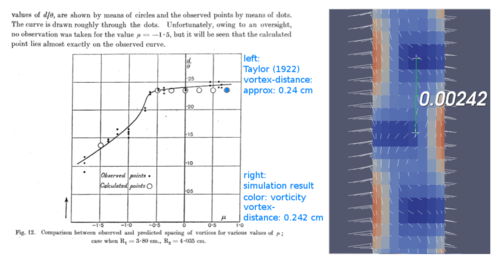Difference between revisions of "Taylor Couette flow by Andras Horvath"
Jump to navigation
Jump to search
Jozsef Nagy (talk | contribs) |
(Added picture from tutorials.) |
||
| (2 intermediate revisions by 2 users not shown) | |||
| Line 1: | Line 1: | ||
| + | [[category:basic tutorial]] | ||
| + | [[category:laminar]] | ||
* '''contributor''': Andras Horvath | * '''contributor''': Andras Horvath | ||
* '''affiliation''': Rheologic GmbH | * '''affiliation''': Rheologic GmbH | ||
* '''contact''': <mail address='andras.horvath@rheologic.at' description='author'>click here for email address</mail> | * '''contact''': <mail address='andras.horvath@rheologic.at' description='author'>click here for email address</mail> | ||
| − | * '''OpenFOAM version''': | + | * '''OpenFOAM version''': v1812 |
* '''published under''': CC BY-ND license ([https://creativecommons.org/licenses creative commons licenses]) | * '''published under''': CC BY-ND license ([https://creativecommons.org/licenses creative commons licenses]) | ||
| Line 8: | Line 10: | ||
=[http://rheologic.net/sites/default/files/pdf/taylor_couette_tutorial-20160913.pdf Taylor Couette flow]= | =[http://rheologic.net/sites/default/files/pdf/taylor_couette_tutorial-20160913.pdf Taylor Couette flow]= | ||
| + | |||
| + | [[File:Taylor_Couette_Flow.png|500px|right|]] | ||
In this [http://rheologic.net/sites/default/files/pdf/taylor_couette_tutorial-20160913.pdf pdf] you will find a compact description of a well known flow from literature. In this tutorial you will run a simple steady-state simulation, where you can directly compare the quality of your results with literature values. | In this [http://rheologic.net/sites/default/files/pdf/taylor_couette_tutorial-20160913.pdf pdf] you will find a compact description of a well known flow from literature. In this tutorial you will run a simple steady-state simulation, where you can directly compare the quality of your results with literature values. | ||
Revision as of 10:45, 12 February 2019
- contributor: Andras Horvath
- affiliation: Rheologic GmbH
- contact: click here for email address
- OpenFOAM version: v1812
- published under: CC BY-ND license (creative commons licenses)
Go back to Day 2.
Taylor Couette flow
In this pdf you will find a compact description of a well known flow from literature. In this tutorial you will run a simple steady-state simulation, where you can directly compare the quality of your results with literature values.
You can download the case files here.
In this tutorial we focus on:
- case, geometry and mesh setup
- boundary conditions
- solution evaluation and post processing
- comparison with theory and experiments from literature
